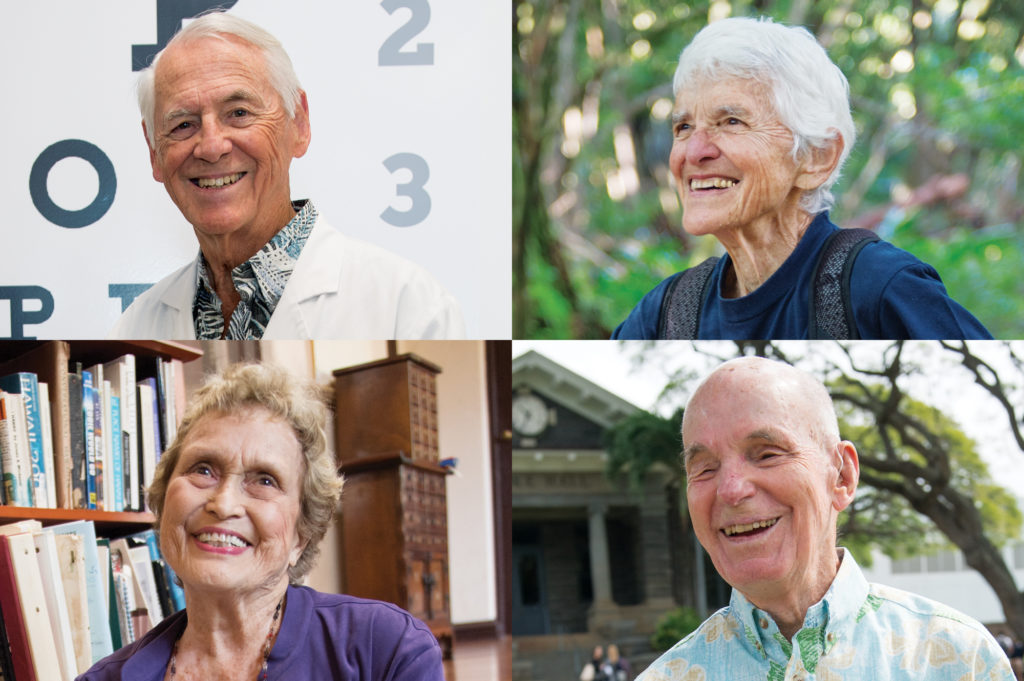
Lives of Passion and Purpose: How four Punahou alumni are thriving — physically, mentally, professionally — well into their 80s.
Story by Camila Chaudron ’08
Photos by Kathleen Connelly
Defining success in education is difficult: What does success look like for our students? How can educators optimize success in the classroom? Punahou parents, teachers, administrators and students are continually re-examining notions of success to create healthier, more balanced learning environments. Yet narrowing down the meaning of success always begets more questions than answers.
One way to measure a school’s success is through its alumni. What types of skills do Punahou alumni possess? What values do they hold dear? What are their attitudes toward learning? How have they fared in life? How have they defined and generated success?
More and more, society is again turning its attention toward its elders for answers to life’s big questions. Just recently, scrolling through my Facebook feed, I stumbled upon a video of a gymnast in her 90s who can land flips most teens would never dream of attempting; the story of an environmental scientist, well past retirement age, who discovered a more efficient method for growing coral reefs; and a New York Times feature on a grandmother who still runs competitively. Clearly, the AARP campaign to #DisruptAging is onto something.
And yet, you don’t have to look far to see Punahou alumni of the same caliber. From a surfing ophthalmologist to a long-distance runner, and from a practicing lawyer to a big-time hiker, the four alumni featured here are all in their 80s and still pushing the boundaries of what’s possible.
By refocusing on the more experienced and resilient among us, these profiles can serve as case studies in how the School’s alumni have achieved their own definitions of success, and embody the Aims of a Punahou Education by living lives of passion and purpose.
Malcolm Ing ’52
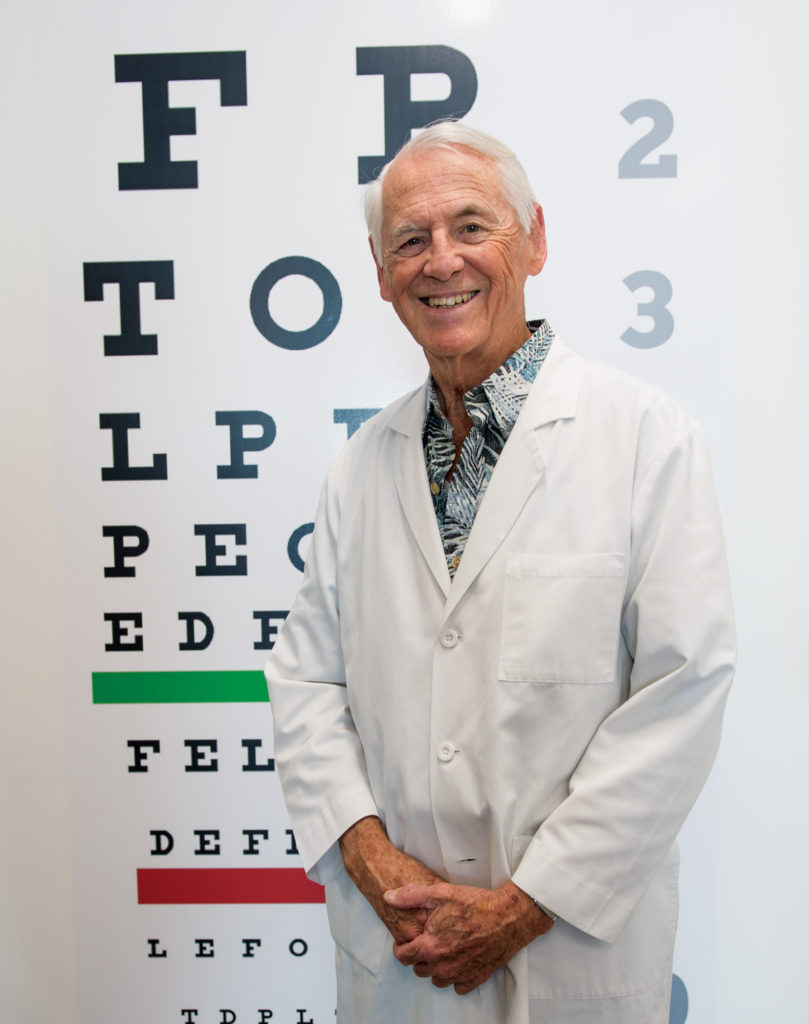
It’s a late weekday afternoon and Dr. Malcolm Ing ’52 is busy at work in his office. He is still updating patient profiles when we meet for a chat to reflect on his life and his long career as an ophthalmologist. Cloaked in a crisp white laboratory coat, Ing strides agilely across the clinic. His office looks out over a gorgeous panorama of swaying palm trees, the cool blue waters of Ala Moana Beach Park stretching out into the distance. On the wall facing the beachfront hangs a large photograph of a surfer gliding across a perfectly breaking wave; a beautiful wood-paneled surfboard hangs in the anteroom, imbuing the modern facility with a classic surf aesthetic.
By almost every measure, Ing has achieved success and could happily live out a quiet retirement with his wife. “But why would I want to stop?” he recalls telling Harvard University classmates at their recent 60th alumni reunion. And indeed, Ing remains very much in motion. At 82, he is a practicing surgeon, researcher and Ophthalmology Chair at John A. Burns School of Medicine at University of Hawai‘i.
Ing’s persistence and drive have kept him on the cutting edge of innovation throughout his long career. The eye doctor, who has performed corrective surgeries on over 6,000 patients, recently learned and became certified to operate using the latest laser technology, which he uses to treat patients with glaucoma. He was also the featured keynote speaker at the 2015 International Ophthalmology Conference, presenting a rare 20-year follow-up study on best practices for treating childhood vision impairments.
Ing hadn’t always dreamed of becoming a doctor. When he was a student at Punahou, he liked his science teachers, but he was more interested in visual arts and had hoped to become a painter. However, his father, a physician, convinced young Malcolm to study pre-med as an undergraduate. Now Ing sees his work as a doctor as his unique brand of artistry. “Ironically, surgery is a form of art,” Ing says, and it’s a form of art that can change lives. Ing’s pioneering research work in the field of childhood visual development has helped countless children born with strabismus (cross-eye) regain control of their vision.
Surfing is another art form that Ing practices regularly. At least twice a week, the fit octogenarian paddles out to local breaks like Bowls or Kewalos on his 8-foot-6 fiberglass longboard, taking time to immerse himself in the restorative energy of the ocean. “If you’re going to be successful, it’s your responsibility to keep yourself in good health,” Ing says of the importance of work-life balance.

Not to be outdone, Ing also competes in local surf competitions, entering what he jokingly calls the “Medicare Division.” But that doesn’t stop Ing from charging big waves – in early March, he and his friends paddled into high surf at Hale‘iwa. “It was 8 to 10 feet and glassy – enough to make the hair on your head rise!” The photograph of that graceful surfer hanging on his office wall? “That’s me,” he says with pride. Surf is clearly more than an aesthetic; for Ing, surfing is an important lifestyle choice.
“Your body is your temple,” he reflects, taking a serious tone. This philosophy has worked well for Ing, who employs a very active approach to maintaining both his physical and mental health. He doesn’t smoke, is careful to minimize sun exposure, and eats a balanced diet. After all, the doctor says, “An ounce of prevention is worth a pound of cure.”
Peg Deschwanden ’48 Foster
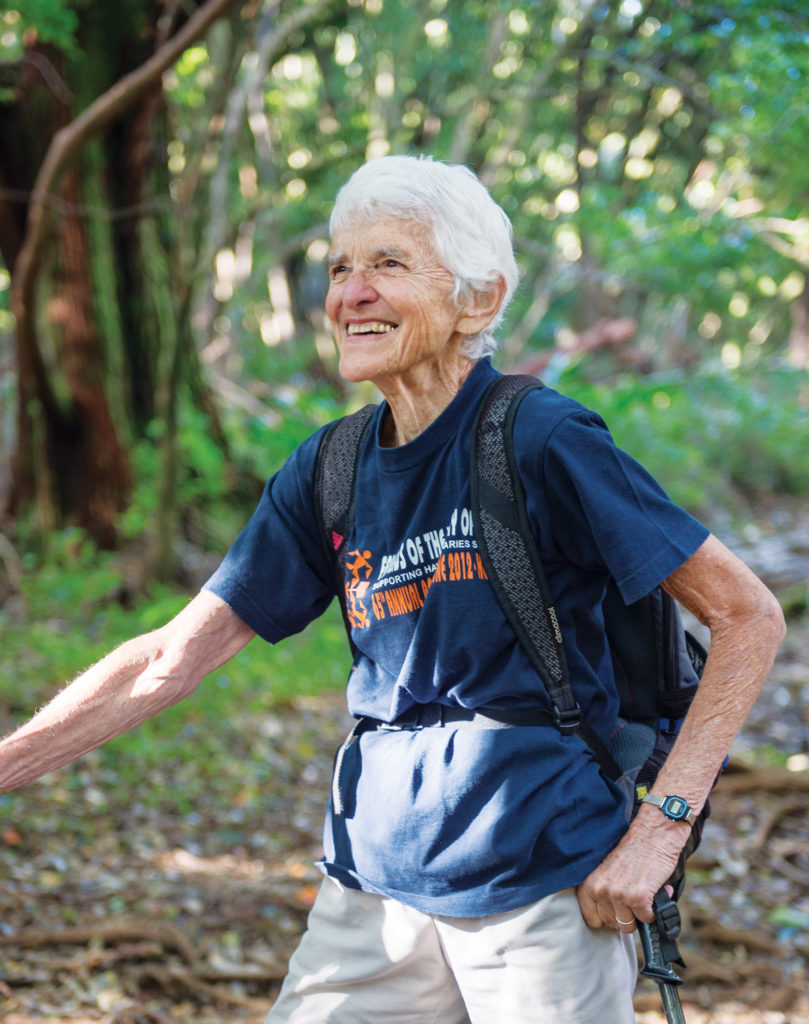
A sinewy woman with a broad smile and bright eyes, Peg Deschwanden ’48 Foster stands waiting at the entranceway of her residence on a recent Saturday afternoon to greet me. After a warm welcome in the lobby, she casually mentions that she lives on the 13th floor of her building – would we care to walk up? Unusual at any age, her request is all the more surprising when you consider that Foster is now squarely in her mid-80s. And yet she charged up hundreds of stairs with the steadiness of a true athlete. This type of vigorous activity is not unusual for Foster; she climbs up and down her building half a dozen times a day.
And Foster has conquered a lot more than stairs: She has scaled an icy Mont Blanc in France; climbed to the peak of Mount Kilimanjaro in Tanzania; summited “Fuji-San” in Japan; and even reached the snowy base camp of Mount Everest in Nepal. The mountain she’s most proud of climbing is the least well-known: the Chimborazo volcano, in the Andean mountains of Ecuador, which rises 20,549 feet above sea level.
In fact, Foster has climbed several of the highest mountains on Earth, and has covered a lot more ground besides. During her travels, she learned foreign languages, volunteered for nonprofits, collected artifacts and made great friends trekking across the globe. We met to discuss her adventures, but Foster quickly discovered her interviewer speaks French – and promptly switched gears to continue the interview in fluent français. This effortless grace and humility are characteristic of Foster; as she works her way through the story of her life, she is keen to mention the many accomplishments of her classmates, friends and family.
Growing up on Kaua‘i, Foster spent most of her childhood running around on the sugar plantations or body surfing in the sparkling sapphire waters of Po‘ipu Bay. Recognizing her sharp intellect, a Kaua‘i local and Punahou alumna Mabel Wilcox (1901) interviewed young Peg in 1945 and quickly sent her packing to Honolulu, where Foster attended Punahou for her last three years of high school.
By the time she graduated from high school, Foster had effectively lived independently for many years, to which she attributes her strong sense of autonomy. Post Punahou, Foster studied chemistry at Monmouth College in Illinois, and met her husband, Dick, an engineer. The rest is history.
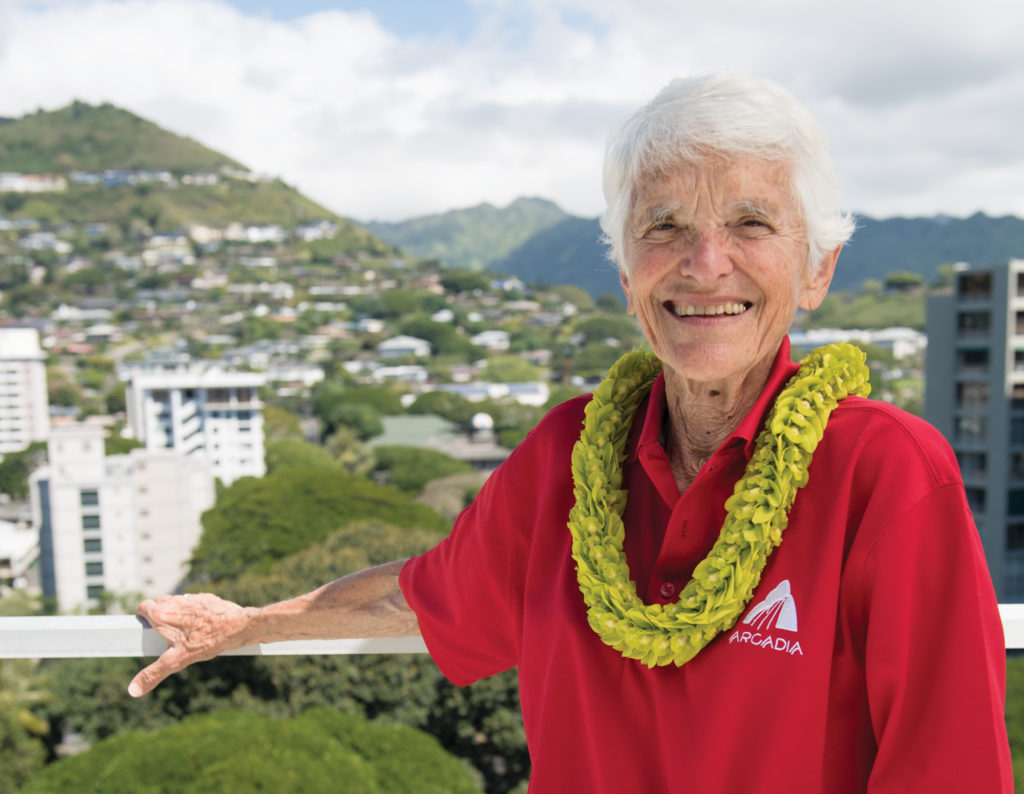
The Fosters have lived for extended periods of time in California, Japan, Canada, France, Germany, Belgium, England, Saudi Arabia, Egypt, Ireland, Holland, Scotland and Norway. Every change of locale offered a new opportunity for learning. She practiced Arabic in the Middle East, studied Japanese when they first moved to Asia, and researched the history of each new country as she made her way around the world. A decade ago, they decided to settle down in Hawai‘i because of the temperate climate the Aloha State offers – not to mention the incredible hiking opportunities.
Hiking has been Foster’s passion for several decades now, mainly because “you meet the nicest people.” If the people you meet hiking are half as nice as Foster, her friendly dictum is certainly true. Twice a week, Foster, the oldest participating female member of the Hawai‘i Trail and Mountain Club, dons her boots, hikes trails and blazes the path for the next generation of active women exploring the great outdoors.
Beadie Kanahele ’47 Dawson

“At the time, I didn’t realize I was learning,” says Beatrice “Beadie” Kanahele ’47 Dawson, reflecting on her childhood. “Only in retrospect” did she realize that learning occurs both explicitly and implicitly; from parents and teachers, Dawson learned and internalized the values that propelled her to the heights of professional success.
Humility, responsibility, respect – these have guided Dawson throughout her life as a public servant and as a professional advocate for Native Hawaiians. A highly respected attorney, Dawson has been fighting for recognition, reconciliation and equality for Native Hawaiians for over 30 years.
Dawson served as the Hawai‘i State Attorney General from 1982 – 1996. Even in her position of power, she never lost sight of her mission to help the disenfranchised. “Once you realize that others are suffering,” she says, “you have to do something. It doesn’t matter who they are that you’re helping.”
Now a vivacious 87-year-old, Dawson is still actively involved in many nonprofit organizations in the Islands. Her commitment to helping others has taken Dawson to prisons, where she met regularly with inmates; to shelters for the homeless; to public schools; and often into the center of conflict. “I’ve always gravitated to places where people need help,” she says. “It’s what feels natural to me.”
Dawson attributes her passion for helping others to her teachers, including her very first mentors: her parents. Dawson’s mother, an educator, would often act as a kahu or arbitrator when her students were dealing with family issues at home. Dawson also recalls her Ka Punahou advisor, who taught her that “you either got something right the first time, or you did it again.” Working on the newspaper, she learned to “deal with facts and digest them, so that you can talk about the issues from diverse perspectives.”
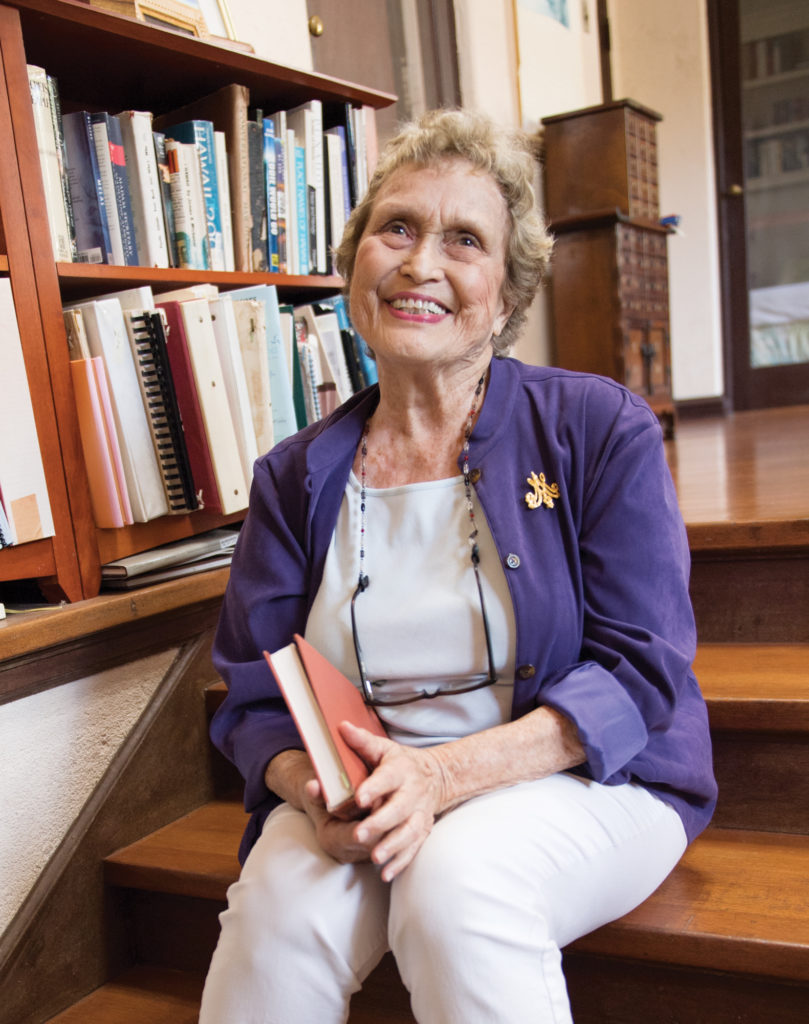
Sitting on the stairs in her home, surrounded by her Hawaiiana book collection, Dawson is still overcome by the passion that brought her into the fold of public service many years ago. While reminiscing on her early years, she recounts that it was a fellow Punahou alumnus, Myron B. “Pinky” Thompson ’43, who motivated her to take direct action. At the time, Thompson was the director of the Department of Social Services and Housing, and Dawson says she “was vocally criticizing what they were doing.” So, Thompson wisely hired her as a speechwriter. This job required that she listen to people, understand their problems and then search for solutions. Eventually, Dawson decided that she “didn’t just want to write about the issues,” but rather she “wanted to do something about them.”
These experiences marked Dawson profoundly, and they went on to shape the trajectory of her career, especially as she broke through glass ceilings and fought against racism and inequality. Dawson continues to be involved in conflict resolution efforts; recently, she attended a convention to train attorneys in the art of ho‘oponopono. This uniquely Hawaiian form of resolving disputes requires introspection, taking responsibility, showing respect and forgiveness. “If we could begin to apply ho‘oponopono internationally,” Dawson believes there would be more peace in the world.
“Paying it forward is a privilege,” Dawson says, echoing the message that President Jim Scott ’70 consistently shares with the students of Punahou. A breathing embodiment of this adage, in February 2017, Dawson was recognized by Honpa Hongwanji Mission as a Living Treasure of Hawai‘i for her “continuous growth in her field” and her dedication to excellence.
Kit Smith ’52
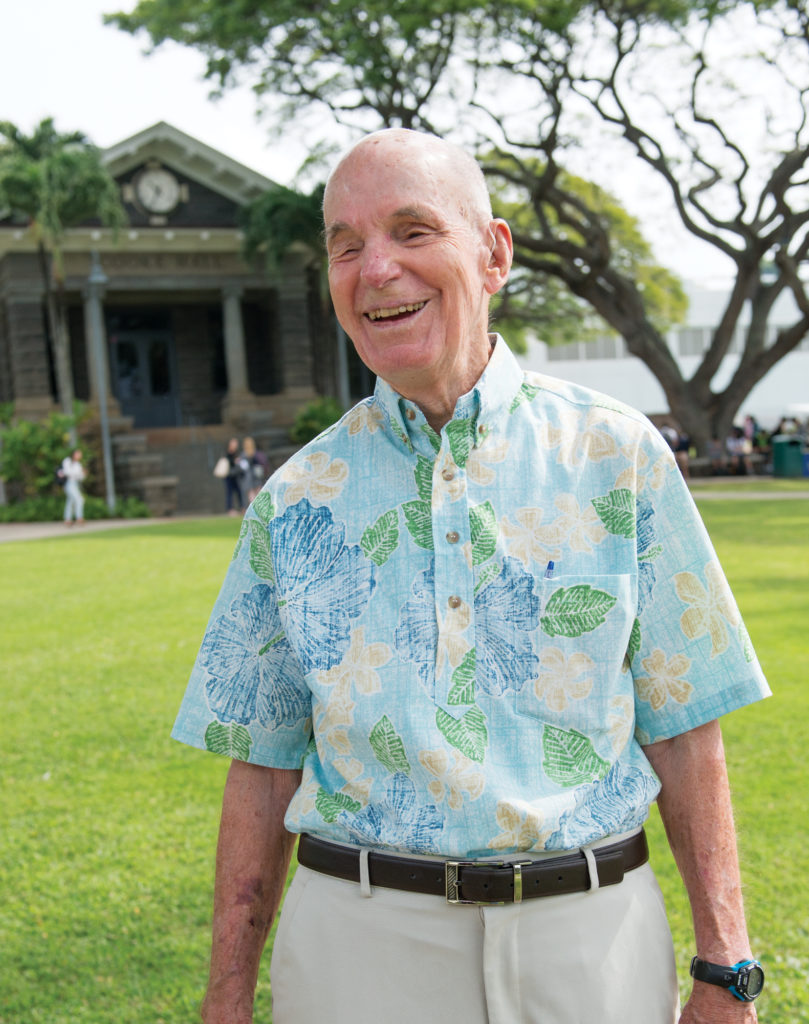
If there’s one notion Christopher “Kit” Smith ’52 swears by, it’s that “keeping fit is very important.” This might be an understatement when it comes to him: Even at 82, Smith continues to run five times a week, averaging 5 to 6 miles a run on weekdays and closer to 10 miles on weekends. “But that’s less now than before,” he says humbly, and not without a hint of remorse.
Smith has run marathons all across the U.S., including in Chicago, New York City, Boston, Philadelphia, San Diego and Honolulu. To celebrate his 50th wedding anniversary, he convinced his wife, Marjorie, to run one with him in Anchorage, Alaska. “I had to wait for her for a while at the finish line,” Smith muses, “but she was well worth the wait.” Despite his dedication to going the extra mile, Smith didn’t actually start running until later in life.
His first real passion, both at Punahou and at Princeton, was the trombone. He played in the marching band in high school and then studied music as an undergraduate. Later, when he finally resettled in Hawai‘i, Smith joined the Honolulu Community Band, now known as the Honolulu Wind Ensemble.
First, though, Smith spent two years in the Navy, where he was posted in Maryland and later on a destroyer at Naval Station, Long Beach. He then went to Stanford, where he got a graduate degree in communications and journalism, and where he met his wife. After spending several years as a financial business news writer in California, he and his young family made the move back home when he got a job editing for the financial section of the Honolulu Advertiser. Smith remained at the Advertiser for the remainder of his career, spending 24 years editing and reporting locally.
Upon arriving back in Hawai‘i, the Smiths took up residence in Hawaii Kai and haven’t moved since. Smith knows the neighborhood like the back of his hand, as he runs through the area almost daily.
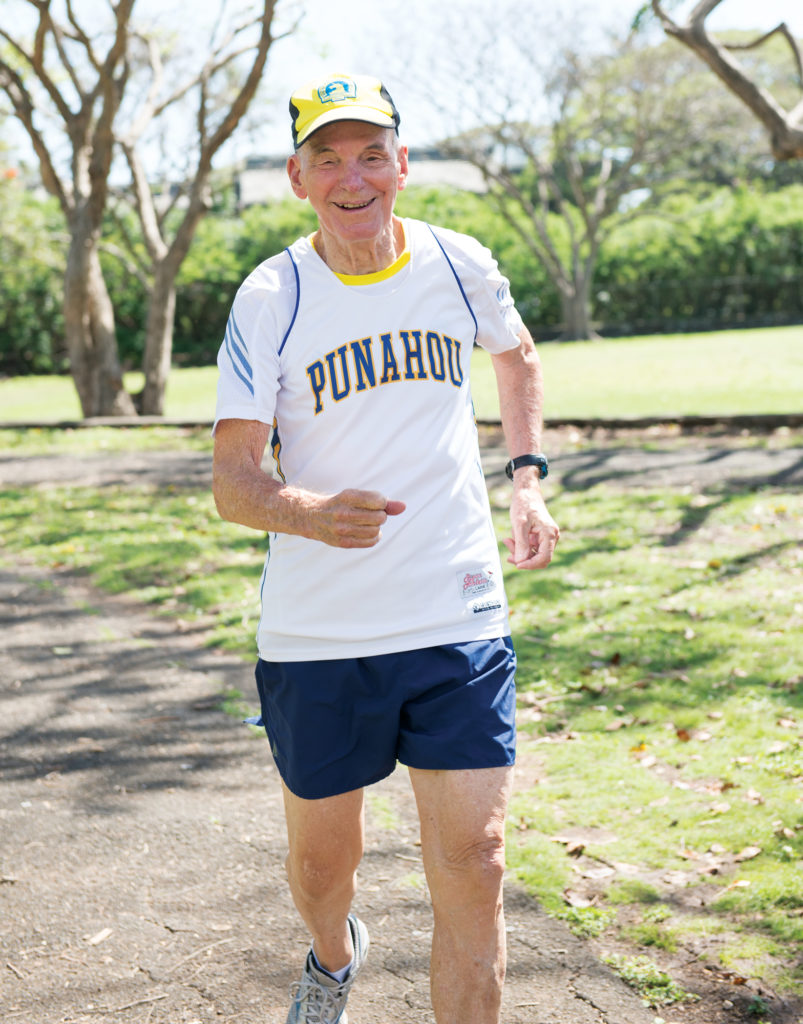
Sadly, the Smiths are also familiar with tragedy. Their middle daughter, Patty ’80, was diagnosed with non-Hodgkin lymphoma when she was only 17. Patty was a bright young girl, a poet, well-read, the senior editor of the Oahuan, and a very dedicated long-distance runner who completed the Honolulu Marathon in high school. Within a year, the cancer had spread throughout her body, and Patty died at the young age of 18, having just started school at Stanford University.
Patty’s story is tragic, but Smith has been able to preserve her memory in many ways, including through a book of Patty’s letters and journal entries. “Mango Days,” which was compiled posthumously and introduced and annotated by Smith, is now in its third printing. Running is another way that Smith has been able to honor his daughter. After her death, friends and family established a benefit run in Patty’s name. Today, that run is called the Mango Days 5K, part of the annual Tropical Triple Crown, which Smith and friends run every year. At Punahou, the Patty Smith ’80 Poetry Fund was established in her memory.
While the Smiths are dedicated to continuing to honor Patty, “you always have to look forward,” Smith says. Just recently, he finished the 8.2-mile Great Aloha Run, along with his youngest daughter, Sandy ’82, and hopes to run in a half-marathon soon. “When you stop looking forward to things, that’s when you quit.” And if there’s anything that is certain, Smith is no quitter.
Live in the Moment
Punahou alumni are arguably one of the strongest testaments to the enduring legacy of passion and purpose that spring forth from Ka Punahou.
As to the question of how to make success possible, we need only to listen to the advice of these inspirational octogenarians: “Plan ahead,” says Ing. “Keep on moving,” recommends Foster. “Listen, forgive, and pay it forward,” advises Dawson. And finally, “live in the moment,” Smith says with earnest. You never know how life will turn out, so do your best and “carpe diem.”
Camila Chaudron ’08 is an English teacher in the Academy.
